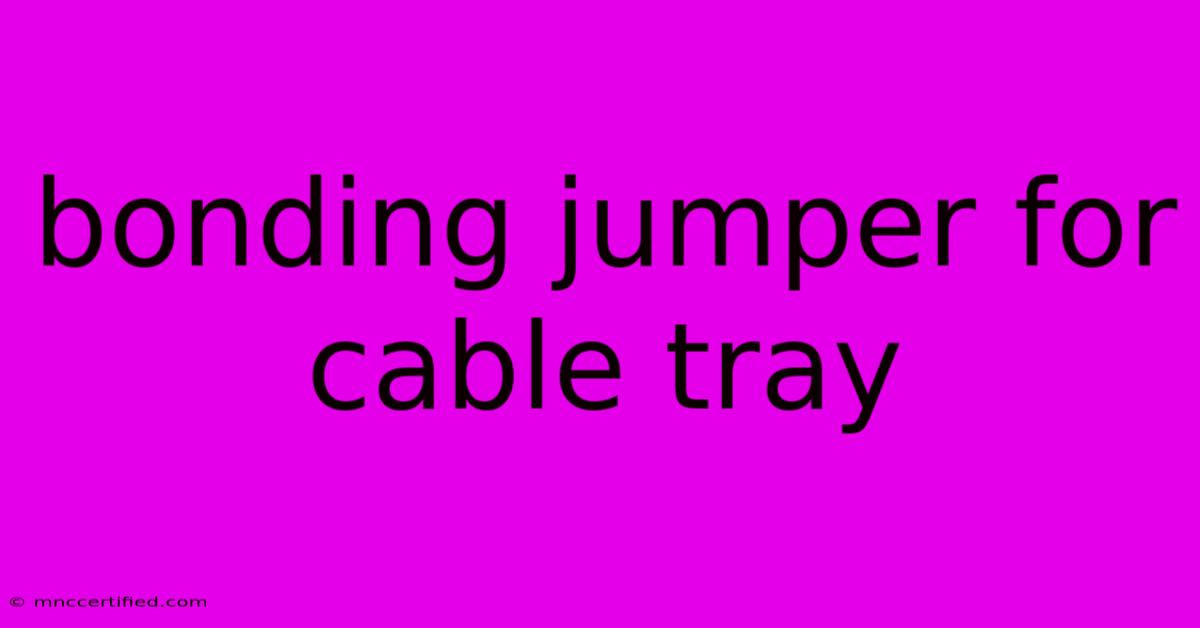Bonding Jumper For Cable Tray

Table of Contents
Bonding Jumpers for Cable Trays: Ensuring Electrical Safety and Code Compliance
Cable trays, essential components in electrical installations, require careful consideration of safety and code compliance. A crucial aspect often overlooked is the proper installation and function of bonding jumpers. This article delves into the vital role of bonding jumpers for cable trays, explaining their purpose, types, installation procedures, and the consequences of neglecting this critical safety measure.
What is a Bonding Jumper for Cable Tray?
A bonding jumper for a cable tray is a conductive pathway that connects the metallic cable tray system to the building's grounding system. This connection equalizes the electrical potential across the entire tray, preventing dangerous voltage buildup and ensuring the safe dissipation of fault currents. Essentially, it's a critical component in protecting both equipment and personnel from electrical hazards. Ignoring proper bonding can lead to serious consequences, including electric shock, equipment damage, and even fire.
Why are Bonding Jumpers Necessary?
Several factors highlight the importance of bonding jumpers in cable tray systems:
- Ground Fault Protection: In the event of a ground fault, the bonding jumper provides a low-impedance path for the fault current to flow to the earth, tripping the circuit breaker and preventing dangerous voltages from appearing on the cable tray.
- Voltage Equalization: Bonding jumpers ensure that all parts of the metal cable tray are at the same electrical potential. This prevents voltage differentials that can cause arcing, sparking, and potential fire hazards.
- Surge Protection: Bonding jumpers help to mitigate the effects of surges and transients, protecting sensitive equipment connected to the system.
- Code Compliance: Most electrical codes, including the National Electrical Code (NEC), mandate the proper bonding of metallic cable trays to ensure safety and compliance. Failure to comply can result in penalties and legal liabilities.
Types of Bonding Jumpers
Several types of bonding jumpers are suitable for cable tray applications, each chosen based on the specific requirements of the installation:
- Exothermic Welded Jumpers: These provide a permanent, highly reliable connection, offering superior conductivity and durability. They are often preferred for critical applications.
- Compression Connectors: Offering a quick and convenient installation method, these connectors create a secure bond when properly crimped.
- Bolted Jumpers: These are used where a more easily removable connection is desired, providing flexibility for maintenance and upgrades. However, they require careful torque control to ensure reliable conductivity.
Installing Bonding Jumpers: A Step-by-Step Guide
The installation of bonding jumpers requires careful planning and execution to ensure optimal performance. The specific steps may vary depending on the jumper type, but general guidelines include:
- Planning: Determine the required jumper size and type based on the cable tray's size, material, and location. Consult the NEC and relevant local codes for specific requirements.
- Cleaning: Thoroughly clean the surfaces to be bonded to ensure good electrical contact. Remove any paint, dirt, or other contaminants.
- Connection: Securely attach the jumper to the cable tray and the grounding system, ensuring a tight and reliable connection. Follow the manufacturer's instructions for specific jumper types.
- Testing: After installation, test the bonding jumper to verify its continuity and ensure that it provides a low-impedance path to ground. Use a suitable multimeter or specialized testing equipment.
- Documentation: Maintain detailed records of the bonding jumper installation, including the type, size, location, and test results.
Consequences of Improper Bonding
Neglecting proper bonding can lead to several severe consequences:
- Electrical Shocks: Individuals touching the cable tray could receive potentially fatal electric shocks.
- Equipment Damage: Voltage surges and ground faults can damage sensitive equipment connected to the system.
- Fires: Arcing and sparking due to voltage differentials can ignite flammable materials.
- Code Violations: Non-compliance with electrical codes can result in fines and legal repercussions.
In conclusion, bonding jumpers are a critical safety component in any cable tray installation. Understanding their purpose, types, installation procedures, and the consequences of improper bonding is paramount for ensuring electrical safety, equipment protection, and code compliance. Always consult qualified electricians and adhere to relevant electrical codes for safe and effective installation practices.

Thank you for visiting our website wich cover about Bonding Jumper For Cable Tray. We hope the information provided has been useful to you. Feel free to contact us if you have any questions or need further assistance. See you next time and dont miss to bookmark.
Featured Posts
-
Explained Celtics Post Ccv Meeting
Nov 28, 2024
-
Postponed Portsmouth Vs Millwall Floodlight Issue
Nov 28, 2024
-
Dee Devlin Victim Blaming Controversy
Nov 28, 2024
-
Arabian Technical Trading Est
Nov 28, 2024
-
Bailey Real Estate Investments
Nov 28, 2024